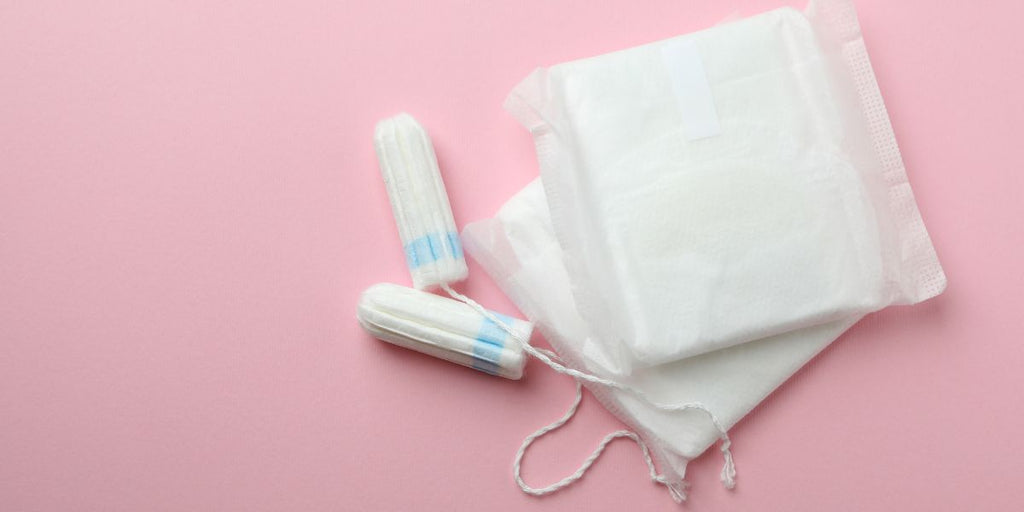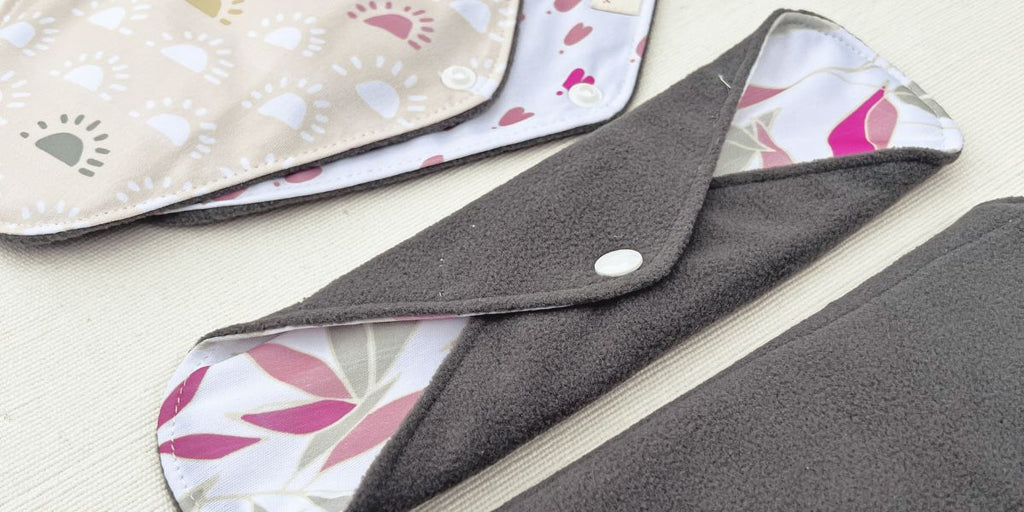Growing up in the 90's
I was 14 years old when I felt that dull ache in my belly and found a bloody spot in my knickers. I remember feeling shocked, although not surprised my time had finally come. My heart sunk a little. My mum and I hadn't spoken much about periods or what to expect. Or at least I can't recall having that conversation. I do remember my girlfriends at school and gymnastics all one-by-one succumbing to the dreaded coming of age. I got a hug from my mum, a pat on the back and trip to the local supermarket to choose a pack of pads where there were lots of handy sizes to choose from. Wings? No wings? Mum and I agreed that wings was the way to go for an active lass like me.
As I picked up the pack of 24 and popped it sheepishly on the cash register, not even a flicker of a thought revolved around what these pads were made from? Or that they would contribute to significant amounts of waste and pollution. It was the 90's. Plastic was in... in a big way. There wasn't a reusable option available in the supermarkets. Ready-to-go convenience foods, Chinese takeaway tubs, throw away nappies and disposable menstrual pads were fantastically convenient. Terms like BPA, micro-plastics, dioxins and phthalates were non existent.

Sometimes we need to go back to go forward
My mum would tell tales of her teen years and wearing home made pads made from 'rags' or left over material from her mothers sewing off cuts. When she had us children (four), she washed and re-used cloth nappies. When I would visit my grandma, although she was well past menopause, I'd often notice strips of cloth in her walker. It didn't really click at the time, but she suffered from incontinence and always had spare 'rags' at hand. I thought this was all gross and majorly archaic.
Fast forward a few decades and we are at war with waste.
Regrettably, it's only in the past decade that my awareness has grown about the considerable environmental impact of the disposable products I once considered convenient – pads, tampons, panty liners, and even disposable diapers. It's become evident how much unnecessary waste these items generate, prompting a shift in my perspective from convenience to sustainability.
What is the environmental impact of single-use disposable menstrual products?
These products generate a large amount of waste, including their packaging and the products themselves, which often end up in landfills and can take hundreds of years to decompose. Additionally, the production of these disposable products contributes to carbon emissions and the depletion of natural resources.
It is estimated that a woman will use approximately 11,000 disposable menstrual products in her lifetime, and these products are often made of non-biodegradable materials such as plastic and synthetic fibres leading to long-term environmental consequences.
Times that by a few billion and its a frightening amount of waste that could simply be avoided by adopting modernised menstrual products from our past.
What are disposable menstrual products made from?
This is probably a question I would have liked my 14 year old self to ask.
Disposable menstrual pads and their packaging often contain various chemicals and synthetic materials. While formulations can vary among brands, here are some common chemicals and materials found in disposable menstrual pads:
-
Dioxins: Some disposable pads may contain trace amounts of dioxins, which are harmful environmental pollutants. Dioxins can be produced during the bleaching process of the materials used in pads.
-
Fragrances: Many disposable pads are scented to mask odours. Fragrances can contain a mix of chemicals that may cause irritation or allergic reactions for some individuals.
-
Chlorine: Bleaching agents, such as chlorine, are used in the manufacturing process to whiten the materials used in pads. Residual traces of chlorine may be present in the final product.
-
Adhesives and Glues: Disposable pads often use adhesives to keep them in place. These adhesives may contain chemicals such as styrene, which can be a skin irritant.
-
Super Absorbent Polymers (SAPs): SAPs are used to enhance absorbency in disposable pads. While generally considered safe, some individuals may be sensitive to these materials.
-
Polyethylene and Polypropylene: These are types of plastic used in the outer layers and backings of disposable pads. They contribute to the water-resistant properties of the pad but are not biodegradable.
-
Synthetic Fabrics: Disposable pads often include synthetic materials like rayon or polyester, which are derived from petrochemicals. These materials are chosen for their absorbent qualities but are not environmentally friendly.
-
Phthalates: Plasticisers, including phthalates, may be used in the production of some components of disposable pads. Phthalates are chemicals that have been associated with potential health concerns.
Not only are these chemicals harmful to personal health, but they also have a detrimental impact on the environment. When these disposable menstrual products are discarded, they contribute to the growing waste crisis and their production further depletes natural resources and contributes to pollution.

The surge of reusable period products
Fortunately, over the past decade, there has been a notable awakening and a growing demand for environmentally conscious feminine hygiene products and low-tox options. The disposable category has witnessed the emergence of organic cotton options, along with a surge in popularity for reusable alternatives such as menstrual cups, washable pads, and period underwear in a range of sizing options.
Why Make the Switch?
Making the switch to reusable period products is a conscientious choice that brings about numerous benefits for both individuals and the environment. Embracing reusable options, such as menstrual cups, washable pads, and period underwear, not only reduces the environmental impact by minimising the disposal of single-use items but also contributes to long-term cost savings. These sustainable options are designed to be durable and long-lasting, providing a sustainable solution that aligns with the principles of waste reduction. Moreover, reusable products often prioritise comfort, offering a healthier and chemical-free experience compared to some disposable counterparts. By making this switch, individuals not only take a positive step towards minimising their ecological footprint but also promote a more sustainable and mindful approach to menstruation.
Cost Comparison: Reusable vs. Disposable Menstrual Products
When comparing the cost of reusable and disposable menstrual products, it's clear that reusable pads have a higher upfront cost, typically ranging from $10 to $20 per pad. However, considering the lifespan of a reusable pad, which can last for several years with proper care, the long-term cost savings are substantial. In contrast, disposable pads may cost around $5 to $10 per pack, but a person may go through several packs each year, leading to higher overall costs
Pros and Cons For Reusable Menstrual Pads vs Period Underwear
Reusable Menstrual Pads:
Pros:
- Less Waste: Reusable cloth pads significantly reduce waste compared to disposable alternatives, contributing to a more sustainable lifestyle.
- Comfort: Many users find cloth pads to be comfortable and breathable, allowing for better airflow during menstruation.
- Cost-Effective: While there's an initial investment, reusable cloth pads can be more cost-effective in the long run as they can last for several years with proper care.
Cons:
- Regular Washing: Cloth pads require washing after each use, which can be less convenient for those with a busy lifestyle.
Period Underwear:
Pros:
- Convenience: Period underwear eliminates the need for additional pads or tampons and can be more convenient for some users.
- Eco-Friendly: Like reusable cloth pads, period underwear reduces overall menstrual waste.
- Comfort: Many people find period underwear comfortable and comparable to regular underwear.
Cons:
- Initial Cost: Period underwear may have a higher upfront cost, but it can balance out with long-term savings.
- Limited Absorbency: Depending on the brand and style, period underwear might have limited absorbency compared to other reusable options, which may not be suitable for heavy flow days.
- Washing Routine: Similar to cloth pads, period underwear needs to be washed after each use, which could be perceived as less convenient for some individuals.
- Inconvenient to change: Unlike menstrual pads which can be removed and changed quickly and easily, period underwear require you to completely remove your bottom layers of clothing. This can be inconvenient if you're away from home.
Reusable cloth pads are less expensive and allow for a quicker change over when compared to period underwear.
Ultimately, the choice between reusable cloth pads and period underwear depends on personal preferences, lifestyle, and individual comfort needs. Both reusable alternatives offer environmentally friendly alternatives to disposable products and contribute to a more sustainable menstrual care routine.

What are reusable menstrual pads made from?
Reusable menstrual pads are typically made from a combination of natural fabrics and synthetic materials chosen for their absorbency, comfort, and durability. Here are some common materials used in the construction of reusable menstrual pads:
-
Cotton: Organic cotton is a popular choice for the top layer of reusable pads due to its softness and breathability.
-
Flannel: Soft and absorbent, flannel is often used as an inner layer in reusable pads.
-
Bamboo Charcoal: Bamboo fabric is known for its natural antibacterial properties and high absorbency, making it a sustainable choice for menstrual pads and especially beneficial for sensitive skin.
-
Hemp: Hemp is a durable and absorbent material that is sometimes blended with other fabrics to enhance the pad's performance.
-
Microfiber: Microfiber is a synthetic material known for its excellent absorbency, often used in the core or inner layers of reusable pads.
-
PUL (Polyurethane Laminate): PUL fabric is a waterproof layer often added to the bottom of the pad to prevent leaks. It is a synthetic material but is commonly used in reusable products.
-
Snaps or Velcro: Closure systems are usually made from plastic snaps or Velcro, allowing users to secure the pad in place.
-
Polyester: Some reusable pads may contain polyester as a component, often in the form of fleece, which can add a moisture-wicking property.
It's essential to note that the materials used can vary between brands and specific product lines.
Less waste for a better future
Over the past decade, our journey from household rags to the convenience of disposables has now evolved into a wealth of contemporary reusable choices for menstrual care. Opting for reusable menstrual pads presents a meaningful step toward disposable waste reduction, steering clear of the environmental toll associated with disposable pads and tampons, often destined for landfills. Embracing this sustainable and economical alternative not only lessens our ecological footprint but also fosters a more environmentally conscious approach to feminine health.

What are BodyICE Woman Menstrual Pads made from?
Our reusable menstrual pads are a brilliant eco-friendly alternative to traditional disposables. Delivered in plastic-free packaging, these pads feature an ultra-absorbent bamboo charcoal layer and recycled PUL waterproof fabric, providing leak-proof protection and high absorbency for light, medium, heavy flow, and post-partum bleeding. The bamboo charcoal's natural antibacterial properties minimise odours and offer comfort for sensitive skin. The secure snap buttons secure the wings around your underwear, offering a secure fit and peace of mind throughout your menstrual cycle. For optimal care, simply rinse the pads in cold water before machine washing and air drying.



Leave a comment
All comments are moderated before being published.
This site is protected by hCaptcha and the hCaptcha Privacy Policy and Terms of Service apply.